Natural Food Colors Market Research, 2031
The global natural food colors market was valued at $1.2 billion in 2021, and is projected to reach $3.7 billion by 2031, growing at a CAGR of 11.3% from 2022 to 2031.
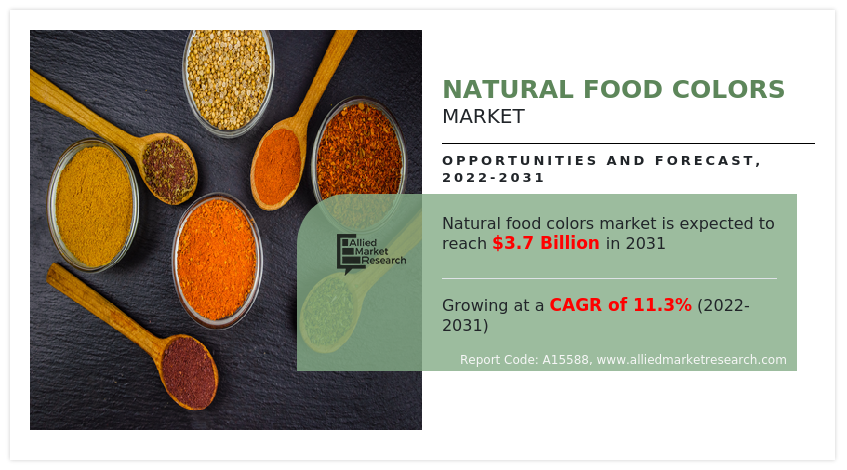
Natural food colors are pigments derived from natural sources such as fruits, vegetables, plants, and minerals. They are widely used in the food and beverages industry by manufacturers to add color to food items or drinks. These natural food colors are available in liquid and powdered forms in the market. Food quality is evaluated on the basis of the color of the food. Food color does not always mean that the ingredients are organic, however, in a few cases, it refers to a lesser amount of ingredients used in it. The less ingredients added, the more natural the food product is. Thus, consumers demand natural and organic ingredients in food colors for a better lifestyle and to minimize the risk of diseases that are caused due to artificial food colors. Natural food colors are generally considered to be safer and healthier than synthetic food colors, which are made from chemicals. They are also more appealing to consumers who are looking for natural and clean-label products, thus creating a huge natural food colors market demand and food manufacturers are intensively capitalizing on new products development and technological advancements to cater to the demand.
Consumers are increasingly looking for natural food ingredients & additives for a variety of reasons in the market. Personal health, food safety, sustainability, transparency, and taste are a few factors supporting the market demand among the food and beverages manufacturers.
Europe is one of the leading regions for the natural food ingredients & additives market, which is impacting the consumption of natural food colors in the market positively. According to the report published by the Centre for the Promotion of Imports- Ministry of Foreign Affairs 2022, the UK is a leading importer of natural food ingredients such as colorants and oleoresins.
The growth of the global natural food color market is driven by an increase in demand for clean label foods and health benefits offered by natural colors. Moreover, the enhanced product appeal offered by these colors to food items boosts their demand across the globe, thereby boosting the market growth. However, the side effects associated with food colors and implementation of stringent regulations toward the use of artificial colors support the market growth. In addition, the high cost of natural colors hampers the growth of the global market. On the contrary, increase in demand for cost-effective products are expected to provide potential opportunities for market expansion during the Natural Food Colors Market Forecast period.
Natural food colors market is gaining huge traction among the food manufacturers in developing economies as they are intensively focusing on evolving preferences of consumers towards the natural sources of food ingredients. The countries such as India, Indonesia, and Vietnam, are becoming a main hotspot for the food ingredients manufacturers to serve an adequate quantity of natural food colors to the food industry. One of the key drivers of the market in India is the government's support for the use of natural colors as the opportunity is still untapped. The Food Safety and Standards Authority of India (FSSAI) has set regulations that limit the use of synthetic food colors and encourage the use of natural colors. This has created a favorable environment for natural food color manufacturers and has helped to boost demand for their products.
Overall, the Natural Food Colors Industry in ASEAN is expected to continue to grow rapidly with a CAGR of 12% during the forecast period, which is driven by increase in demand from the food and beverage industry and the government's support for the expansion of natural colors. This presents opportunities for natural food color manufacturers to expand their businesses and meet the growth in demand for healthier and safer food products.
The ASEAN region dominated by China and India is anticipated to depict promising growth opportunities for the natural food color market during the forecast period. The industry in the region is expected to exhibit the highest growth rate of 12%, owing to a rise in consumer awareness regarding the negative effects of artificial colors coupled with an increase in spending abilities of consumers. Furthermore, the upsurge in disposable income of consumers and high standard of living boost the demand for nutritional and quality food, which, in turn, propel the growth of the market. Moreover, surge in urbanization, increase in working population, and hectic & busy schedule of people fuel the need for products such as dairy products, beverages (soft drinks and energy drinks), and bakery products, to be an integral part of daily life.
Thus, the rise in these industries leads to the growth of the market. With growing health awareness among consumers, China banned the use of 17 artificial food dyes in food products in recent years, which has enforced domestic players to introduce natural-based food colors. Thus, Asia-Pacific is anticipated to propel the market growth in the coming years.
Segment Overview
The natural food color market is segmented into color type, source, form, solubility, application, and region. On the basis of color type, the market is categorized into caramel, carotenoids, anthocyanins, curcumin, carmine, annatto, and chlorophyll & spirulina. By source, the market is bifurcated into plant and animal. On the basis of form, liquid and solid are covered in the report. By solubility, the market is categorized by water and dye. On the basis of application, the market is divided into processed food products and beverages. Region wise, the market is studied across North America which includes the U.S. and Canada, Europe includes Germany, France, UK, Spain, Italy, Russia, Netherlands, and Rest of Europe, and ASEAN includes Malaysia, Indonesia, Philippines, Singapore, Vietnam, Thailand, Brunei, Laos, Myanmar, Cambodia, China, and India.
The report provides a clear picture of the current market situation and future trends of the market based on the impact of various market dynamics and vital forces influencing the market. The drivers and opportunities contributing to the market growth are acknowledged in the market dynamics. Besides, challenges and restraints that can hamper the market growth are also premeditated in the market. Porter's five forces analysis is delivered through the report which precisely highlights the effects of key forces on the market. The report offers market size and estimations analyzing market through various segments.
The natural food colors market is segmented into Application, Color Type, Source, Form and Solubility.
By Color Type
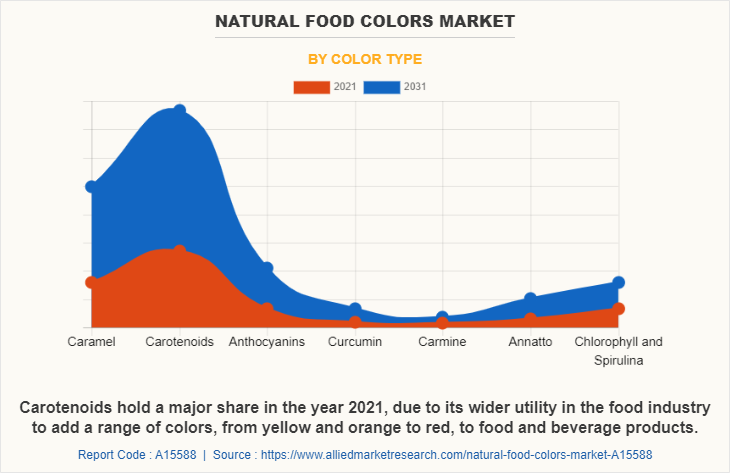
By color type, the market is categorized into caramel, carotenoids, anthocyanins, curcumin, carmine, annatto, and chlorophyll & spirulina. The carotenoids segment held the largest share of more than two-fifths in 2021, followed by the caramel and others. This is attributed to the fact that natural colors have witnessed an increase in demand in various applications, as they make the product more attractive, appetizing, and appealing, allowing consumers to identify products on sight.
By Source
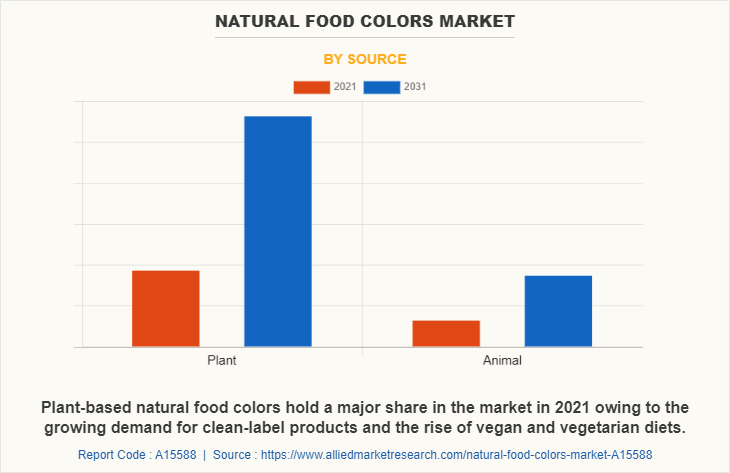
By source, the natural food color market is categorized into plant and animal. The plant segment held the largest share in 2021, followed by the animal segment. Plant-based natural food colors are perceived as clean-label ingredients because they are derived from natural sources. Thus, the plant-based natural food colors are expected to grow with the highest CAGR of 11.5% during the forecast period.
By Form
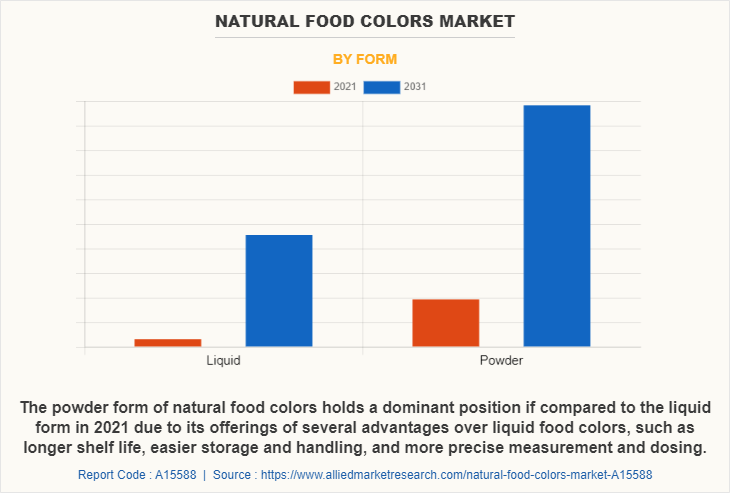
By form, the market is categorized into liquid and powder. The powder segment held the largest share in 2019, accounting for around 67% of the total revenue, followed by the artificial segment. Powdered natural food colors offer several advantages over liquid food colors, such as longer shelf life, easier storage and handling, and more precise measurement and dosing. Additionally, many powdered natural food colors are also water-soluble, making them easier to incorporate into food products. Manufacturers majorly use this form in their food production process as compared to the liquid form.
By Solubility
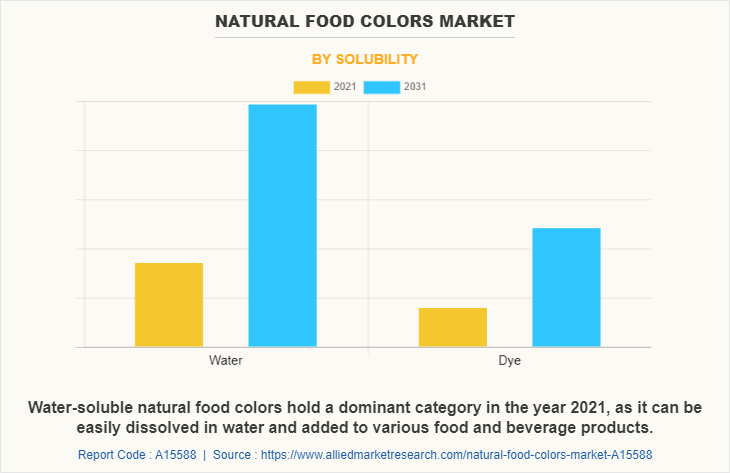
The segments covered by solubility in the study include water and dye. The water segment held the major share in 2021, accounting for nearly two-thirds of the global market, and is expected to retain its dominance throughout the forecast period. This is attributed to the rise in preferences of food manufacturers toward water-soluble food colors due to their ease of use and effectiveness.
By Application
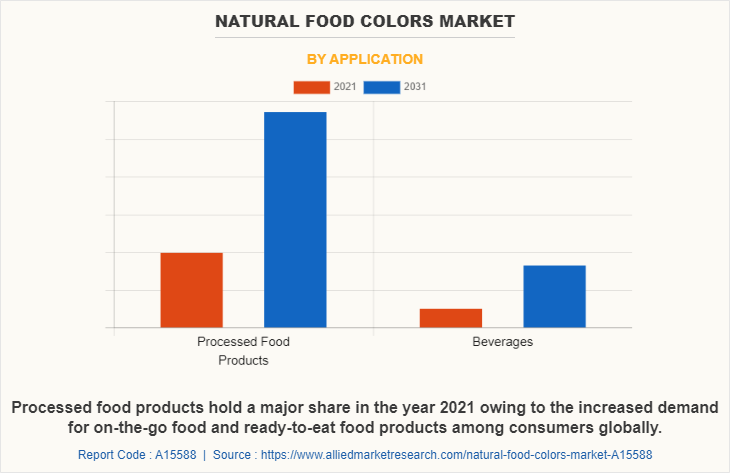
The applications covered in the study include processed food products and beverages. The processed food products segment held the major share in 2021, accounting for four-fifths of the global natural food colors market share and is expected to retain its dominance throughout the forecast period. This is attributed to a rise in demand for global dairy products and meat products, owing to a surge in awareness about the various health benefits associated with the consumption of dairy and meat-related products.
By Region
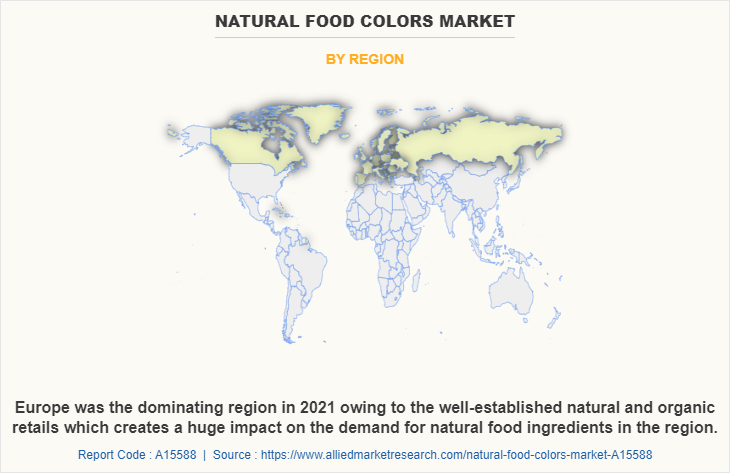
Region-wise, the natural food colors market size is analyzed across North America (U.S., and Canada), Europe (Germany, France, UK, Spain, Italy, Russia, Netherlands, and Rest of Europe), and ASEAN (Malaysia, Indonesia, Philippines, Singapore, Vietnam, Thailand, Brunei, Laos, Myanmar, Cambodia, China, and India).
ASEAN region is expected to exhibit a significant growth rate in the future, owing to a rise in demand among food manufacturers for different types of natural food colors made from naturally occurring substances. In addition, the region has witnessed a considerable surge in the number of millennials, who are the leading consumers of natural packaged food. Therefore, rise in millennial population is anticipated to offer remunerative opportunity for the natural food colors market growth in ASEAN region.
Competition Analysis
The key players profiled in this report are Koninklijke DSM N.V., Givaudan SA, Nactarome S.p.A., T. Hasegawa Co., Ltd., GNT International B.V., Archer-Daniels-Midland Company, Taiyo Kagaku Co., Ltd., International Flavors & Fragrances Inc., V. MANE Fils SAS, Hawkins Watts Limited, BioconColors, Robertet Group, California Natural Color, Byrnes & Kiefer Company, The Watkin Company, Sensient Technologies Corporation, San-Ei Gen F.F.I., Inc., Gulf Flavours & Fragrances, Orginor Natural SA, Vivify, Kalsec, Inc., Oterra A/S, Kanegrade Limited, and Dohler GmbH. Further, the report offers a thorough analysis of the natural food colors market with a detailed study of various aspects of the market such as market dynamics, vital segments, major regions, key players, and competitive landscape.
Recent Product Launch in Natural Food Colors Market
- In July 2020, DDW, Inc., subsidiary of Givaudan SA, launched new line of organic colors that includes Naturbrown Apple, which provides dark red-brown color. This launch expanded its current product offering in natural food color product line.
- In March 2022, Archer-Daniels-Midland Company launched PearlEdge, which is new product line which offers white color shades and it is primarily prepared from corn starch, and mainly marketed towards food and beverages applications. This launch has further expanded its natural food color offering and alternative to titanium dioxide.
- In January 2023, EXBERRY brand of GNT International B.V., based in Europe, launched new natural color which is prepared from carrots. This products is mainly marketed towards meat and plant-based alternatives to incorporate red color. This launch has expanded its product offering to its customers.
- In November 2022, EXBERRY brand of GNT International B.V., in Europe, launched new natural color which is prepared from turmeric and spirulina. This launch includes EXBERRY Shade Bright Green, and this is mainly offered to dry and powdered applications.
Recent Business Expansions in Natural Food Colors Market
- In November 2022, EXBERRY brand of GNT International B.V., has acquired regulatory approval from U.S. Food and Drug Administration (FDA). This approval will enable it to incorporate spirulina extract in development of blue colors and will further is product portfolio in natural colors market.
- In September 2022, GNT International B.V., in Germany demonstrated its various applications of its natural colors in non-alcoholic beverages at drinktec. With this it will expand its business presence through increasing its consumer base.
Key Benefits For Stakeholders
- This report provides a quantitative analysis of the market segments, current trends, estimations, and dynamics of the natural food colors market analysis from 2021 to 2031 to identify the prevailing natural food colors market opportunities.
- The market research is offered along with information related to key drivers, restraints, and opportunities.
- Porter's five forces analysis highlights the potency of buyers and suppliers to enable stakeholders make profit-oriented business decisions and strengthen their supplier-buyer network.
- In-depth analysis of the natural food colors market segmentation assists to determine the prevailing market opportunities.
- Major countries in each region are mapped according to their revenue contribution to the global market.
- Market player positioning facilitates benchmarking and provides a clear understanding of the present position of the market players.
- The report includes the analysis of the regional as well as global natural food colors market trends, key players, market segments, application areas, and market growth strategies.
Natural Food Colors Market Report Highlights
| Aspects | Details |
| Market Size By 2031 | USD 3.7 billion |
| Growth Rate | CAGR of 11.3% |
| Forecast period | 2021 - 2031 |
| Report Pages | 483 |
| By Solubility |
|
| By Application |
|
| By Color Type |
|
| By Source |
|
| By Form |
|
| By Region |
|
| Key Market Players | Byrnes & Kiefer Company, The Watkin Company, BioconColors, Taiyo Kagaku Co., Ltd., Robertet Group, Kanegrade Limited, Kalsec, Inc., International Flavors & Fragrances Inc., Orginor Natural SA, Archer-Daniels-Midland Company, Vivify , Koninklijke DSM N.V., Sensient Technologies Corporation, Givaudan SA, Gulf Flavours & Fragrances, T. Hasegawa Co., Ltd., V. MANE Fils SAS, GNT International B.V., Hawkins Watts Limited, Dohler GmbH, California Natural Color, Oterra A/S, San-Ei Gen F.F.I., Inc., Nactarome S.p.A. |
Analyst Review
According to top-level CXOs, innovation in the natural food ingredients is the key factor for the growth of the global natural food color market. Rise in demand for various natural colors from target customer makes way for the manufacturers to come up with innovation in food colors, which is anticipated to boost the growth of the market.
The CXOs further added that manufacturers are focusing on displaying the transparency of the ingredients, which are added in the product, as majority of the consumers choose products by reading the labels and information of source of ingredients. In addition, consumers prefer products with lesser number of ingredients. Moreover, the increase in curiosity of millennials to try innovative and natural food boosts the growth of the natural food color market.
Furthermore, rise in rate of internet penetration around the major parts of the world makes way for manufacturers to initiate several key online marketing programs. These online platforms are one of the easiest ways to create awareness about the specifications and features of the natural ingredients such as natural food colors among the target customers. Hence, tapping into such markets is expected to create potential opportunities for the expansion of the global natural food colors market.
The natural food colors market valued for $1,242.80 million in 2021 and is estimated to reach $3,672.00 million by 2031.
The forecast period in the market report would be 2022-2031.
The natural food colors market valued for $1,242.80 million in 2021.
The year 2021 is base year calculated in the Natural food colors market report.
Consumers are increasingly looking for natural food ingredients & additives for a variety of reasons in the market. Personal health, food safety, sustainability, transparency, and taste are a few factors supporting the market demand among the food and beverages manufacturers.
The key players profiled in this report are Koninklijke DSM N.V., Givaudan SA, Nactarome S.p.A., T. Hasegawa Co., Ltd., GNT International B.V., Archer-Daniels-Midland Company, Taiyo Kagaku Co., Ltd., International Flavors & Fragrances Inc., V. MANE Fils SAS, Hawkins Watts Limited, BioconColors, Robertet Group, California Natural Color, Byrnes & Kiefer Company, The Watkin Company, Sensient Technologies Corporation, San-Ei Gen F.F.I., Inc., Gulf Flavours & Fragrances, Orginor Natural SA, Vivify, Kalsec, Inc., Oterra A/S, Kanegrade Limited, and Dohler GmbH.
According to the World Trade Organization (WTO) 2021, the global merchandise trades were expected to decline by ~32% in 2020, which was a steeper decline than the 9% contraction recorded during the global financial crises in 2008-2009 and has impacted natural food colors trade negatively.
Europe will dominate the market by the end of 2031.
Loading Table Of Content...
Loading Research Methodology...


